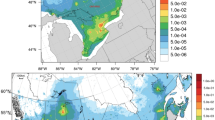Abstract
The health effects of living in proximity to Superfund sites with ongoing remediation were evaluated for residents of two contiguous Montana counties, Deer Lodge and Silver Bow. Deer Lodge and Silver Bow are home to the Anaconda Smelter and Silver Bow Creek/Butte Area Superfund sites, respectively. Established by the Environmental Protection Agency in 1983, both sites have had ongoing remediation for decades. Employing county level death certificate data obtained from the Centers for Disease Control and Prevention WONDER site, sex and age-adjusted standardized mortality ratios (SMRs) for composite targeted causes of death were calculated using observed versus expected mortality for both counties, and compared to the expected mortality from the remaining Montana counties. Cancers, cerebro- and cardiovascular diseases (CCVD), and organ failure were elevated for the two counties during the study period, 2000–2016, with SMRs of 1.19 (95% CI 1.10, 1.29); 1.36 (95% CI 1.29, 1.43); and 1.24 (95% CI 1.10, 1.38), respectively. Neurological conditions were not elevated for the two counties (SMR = 1.01; 95% CI 0.89, 1.14). Time trend analyses performed using Cox regression models indicate that deaths from cancers (HR = 0.97; p = 0.0004), CCVDs (HR = 0.95; p ≤ 0.0001), and neurological conditions (HR = 0.97; p = 0.01) decreased over the study period. While the ecological approach applied limits the interpretation of our results, our study suggests that while mortality is elevated, it is also decreasing over time for these two Superfund sites.




Similar content being viewed by others
References
Agarwal, S., Zaman, T., Tuzcu, E. M., & Kapadia, S. R. (2011). Heavy metals and cardiovascular disease: Results from the National Health and Nutrition Examination Survey (NHANES). Angiology, 1999–2006, 62(5), 422–429.
Arita, A., & Costa, M. (2009). Epigenetics in metal carcinogenesis: Nickel, arsenic, chromium and cadmium. Metallomics, 845, 222–228.
Bonda, D. J., Wang, X., Perry, G., Nunomura, A., Tabaton, M., Zhu, X., & Smith, M. A. (2010). Oxidative stress in Alzheimer disease: A possibility for prevention. Neuropharmacology, 59(4–5), 290–294. https://doi.org/10.1016/j.neuropharm.2010.04.005.
Borné, Y., Barregard, L., Persson, M., Hedblad, B., Fagerberg, B., & Engström, G. (2015). Cadmium exposure and incidence of heart failure and atrial fibrillation: A population-based prospective cohort study. British Medical Journal Open, 5(6), 1–8.
Brown, C. C., & Chu, K. C. (1983). Implications of the multistage theory of carcinogenesis applied to occupational arsenic exposure. Journal of the National Cancer Institute, 70(3), 455–463.
Butte GIS Department. (2006). Butte Superfund NRIS data layers. MT: Butte.
Byrne, C. (2013). Metals and breast cancer. Journal of Mammary Gland Biology and Neoplasia, 18(1), 63–73.
Caffo, M., Caruso, G., La Fata, G., Barresi, V., Visalli, M., Venza, M., et al. (2014). Heavy metals and epigenetic alterations in brain tumors. Current Genomics, 5(6), 457–463.
Campbell, A. (2006). The role of aluminum and copper on neuroinflammation and Alzheimer’s disease. Journal of Alzheimer’s Disease, 10(2–3), 165–172.
Capozzella, A., Sacco, C., Chighine, A., Loreti, B., Scala, B., Casale, T., et al. (2014). Work related etiology of amyotrophic lateral sclerosis (ALS): A meta-analysis. Annali DiIgiene: Medicina Preventiva E Di Comunita, 26(5), 456–472.
Centers for Disease Control and Prevention, National Center for Health Statistics. Multiple Cause of Death 1999–2016 on CDC WONDER Online Database, released December 2017. Data are from the Multiple Cause of Death Files, 1999–2016, as compiled from data provided by the 57 vital statistics jurisdictions through the Vital Statistics Cooperative Program.
Currie, J., Greenstone, M., & Moretti, E. (2011). Superfund cleanups and infant health. American Econimic Review, 101(3), 435–441.
Etemadifar, M., Mehrabi, B., Kiani-Peykani, R., Abtahi, S. H., Nekouie-Isfahani, K., Ramagopalan, S. V., et al. (2016). Soil heavy metals are associated with the distribution of multiple sclerosis in Isfahan, Iran. Acta Neurologica Scandinavica, 134(4), 292–299.
Fagerberg, B., Barregard, L., Sallsten, G., Forsgard, N., Östling, G., Persson, M., et al. (2015). Cadmium exposure and atherosclerotic carotid plaques—Results from the Malmö diet and Cancer study. Environmental Research, 136, 67–74.
Fink, A. K., German, R. R., Heron, M., Stewart, S. L., Johnson, C. J., Finch, J. L., et al. (2012). Impact of using multiple causes of death codes to compute site-specific, death certificate-based cancer mortality statistics in the United States. Cancer Epidemiology, 36(1), 22–28.
Gammons, C. H., Metesh, J. J., & Duiame, T. E. (2006). Overview of the mining history and geology of Butte, Montana. Mine Water and the Environment, 25, 70–75.
Garcia-Esquinas, E., Pollan, M., Umans, J. G., Francesconi, K. A., Goessler, W., Guallar, E., et al. (2013). Arsenic exposure and cancer mortality in a US-based prospective cohort: the strong heart study. Cancer Epidemiology, Biomarkers and Prevention: A Publication of the American Association for Cancer Research, Cosponsored by the American Society of Preventive Oncology, 22(11), 1944–1953.
Hailer, M. K., Peck, C. P., Calhoun, M. W., West, R. F., James, K. J., & Siciliano, S. D. (2017). Assessing human metal accumulations in an urban Superfund site. Environmental Toxicology and Pharmacology, 54, 112–119.
Heo, Y., Parsons, P. J., & Lawrence, D. A. (1996). Lead differentially modifies cytokine production in vitro and in vivo. Toxicology and Applied Pharmacology, 138(1), 149–157.
Hyder, O., Chung, M., Cosgrove, D., Herman, J. M., Li, Z., Gurakar, A., et al. (2013). Cadmium exposure and liver disease among US adults Omar. Journal of Gastrointestinal Surgery, 17(7), 1265–1273.
Jaishankar, M., Tseten, T., Anbalagan, N., Mathew, B. B., & Beeregowda, K. N. (2014). Toxicity, mechanism and health effects of some heavy metals. Interdisciplinary Toxicology, 7(2), 60–72.
Kaji, T., Suzuki, M., Yamamoto, C., Mishima, A., Sakamoto, M., & Kozuka, H. (1995). Severe damage of cultured vascular endothelial cell monolayer after simultaneous exposure to cadmium and lead. Archives of Environmental Contamination and Toxicology, 28(2), 168–172.
Lee, A. M., & Fraumeni, J. F. (1969). Arsenic and respiratory cancer in man: An occupational study. Journal of the National Cancer Institute, 42, 1045–1052.
Lee, M.-S., Park, S. K., Hu, H., & Lee, S. (2011). Cadmium exposure and cardiovascular disease in the 2005 Korea national health and nutrition examination survey. Environmental Research, 111(1), 171–176. https://doi.org/10.1016/j.envres.2010.10.006.
Lee-Feldstein, A. (1986). Cumulative exposure to arsenic and its relationship to respiratory cancer among copper smelter employees. Journal of Occupational Medicine, 28(4), 296–302.
Liu, K., Hao, J., Zeng, Y., Dai, F., & Gu, P. (2013). Neurotoxicity and biomarkers of lead exposure: A review. Chinese Medical Sciences Journal, 28(3), 178–188.
Lubin, J. H., Pottern, L. M., Stone, B. J., & Fraumeni, J. F. (2000). Respiratory cancer in a cohort of copper smelter workers: Results from more than 50 years of follow-up. American Journal of Epidemiology, 151(6), 554–565.
Naujokas, M. F., Anderson, B., Ahsan, H., Aposhian, H. V., Graziano, J. H., Thompson, C., et al. (2013). The broad scope of health effects from chronic arsenic exposure: Update on a worldwide public health problem. Environmental Health Perspectives, 121(3), 295–302.
Nawrot, T. S., Martens, D. S., Hara, A., & Plusquin, M. (2015). Association of total cancer and lung cancer with environmental exposure to cadmium: The meta-analytical evidence. Cancer Causes & Control, 26(9), 1281–1288. https://doi.org/10.1007/s10552-015-0621-5.
Neuberger, J. S., Hu, S. C., Drake, K. D., & Jim, R. (2009). Potential health impacts of heavy-metal exposure at the Tar Creek Superfund site, Ottawa County, Oklahoma. Environmental Geochemistry and Health, 31(1), 47–59. https://doi.org/10.1007/s10653-008-9154-0.
Oliveira, M. D., & Bevan, G. (2003). Measuring geographic inequities in the Portuguese health care system: an estimation of hospital care needs. Health Policy (Amsterdam, Netherlands), 66(3), 277–293.
Racette, B. A., Nielsen, S. S., Sheppard, L., Seixas, N., & Warden, M. N. (2017). Dose-dependent progression of parkinsonism in manganese-exposed welders. Neurology, 88, 344–351.
Rana, S. V. S. (2014). Perspectives in endocrine toxicity of heavy metals—A review. Biological Trace Element Research, 160, 1–14.
Sabath, E., & Robles-Osorio, M. L. (2012). Renal health and the environment: heavy metal nephrotoxicity. Nefrologia, 32(3), 279–286.
Satterly, A. (1995). An epidemiological study to determine if heavy metals are a factor in the etiology of Amyotrophic Lateral Sclerosis (Master of Science Thesis). Butte, MT: Montana Tech of The University of Montana.
Sharma, B., Singh, S., & Siddiiqi, N. J. (2014). Biomedical implications of heavy metals induced imbalances in redox systems. BioMed Research International, 2014, 1–26.
Smith, A. H., Marshall, G., Roh, T., Ferreccio, C., Liaw, J., & Steinmaus, C. (2018). Lung, bladder, and kidney cancer mortality 40 years after arsenic exposure reduction. Journal of National Cancer Institute, 110(3), 1–9.
Soderland, P., Lovekar, S., Weiner, D. E., Brooks, D. R., & Kaufman, J. S. (2010). Chronic kidney disease associated with environmental toxins and exposures. Advances in Chronic Kidney Disease, 17(3), 254–264.
Solenkova, N. V., Newman, J. D., Berger, J. S., & Thurston, G. (2014). Metal pollutants and cardiovascular disease: Mechanisms and consequences of exposure. American Heart Journal, 168(6), 812–822.
Song, J., Luo, H., Yin, X., Huang, G., Luo, S., & Lin, D. (2015). Association between cadmium exposure and renal cancer risk: A meta-analysis of observational studies. Nature Publishing Group, 5(17976), 1–8.
Squitti, R. (2012). Metals in Alzheimer’s disease: a systemic perspective. Frontiers in Bioscience (Landmark Edition), 17, 451–472.
States, J. C., Srivastava, S., Chen, Y., & Barchowsky, A. (2009). Arsenic and cardiovascular disease. Toxicological Sciences, 107(2), 312–323. https://doi.org/10.1093/toxsci/kfn236.
Stohs, S. J., & Bagchi, D. (1995). Oxidative mechanisms in the toxicity of metal ions. Free Radical Biology and Medicine, 18(2), 321–336.
Sutedja, N. A., Veldink, J. H., Fischer, K., Kromhout, H., Heederik, D., Huisman, M. H. B., et al. (2009). Exposure to chemicals and metals and risk of amyotrophic lateral sclerosis: a systematic review. Amyotrophic Lateral Sclerosis: Official Publication of the World Federation of Neurology Research Group on Motor Neuron Diseases, 10(5–6), 302–309.
Tellez-Plaza, M., Guallar, E., Howard, B. V., Umans, J. G., Francesconi, K. A., Goessler, W., et al. (2013). Cadmium exposure and incident cardiovascular disease. Epidemiology (Cambridge, Mass.), 24(3), 421–429.
Tsai, S. P., & Wen, C. P. (1986). A review of methodological issues of the standardized mortality ratio (SMR) in occupational cohort studies. International Journal of Epidemiology, 15(1), 8–21.
US Census Bureau (2017). https://census.gov. Accessed October 13, 2017.
US Environmental Protection Agency, Region 8 (2015). Fifth five-year review report for Anaconda Smelter Superfund Site Anaconda-Deer Lodge County, Montana.
US Environmental Protection Agency, Region 8 (2016). Fourth five-year review report for silver bow Creek/Butte area Superfund Site, Butte, Silver Bow and Deer Lodge Counties, Montana.
US Environmental Protection Agency (2017). News Releases from Region 08. https://www.epa.gov/newsreleases/anaconda-smelter-and-silver-bow-creekbutte-area-among-superfund-sites-targeted Accessed January 11, 2018.
US Environmental Protection Agency (2018). Superfund. https://www.epa.gov/superfund. Accessed October 31, 2017.
US National Cancer Institute of Health, (2009). State Cancer Profiles. Bethesda, MD. http://statecancerprofiles.cancer.gov. Accessed October 14, 2017.
Vaziri, N. D., Ding, Y., & Ni, Z. (2001). Compensatory up-regulation of nitric oxide synthase isoforms in lead-induced hypertension; reversal by a superoxide dismutase-mimetic drug. Journal of Pharmacology and Experimental Therapeutics, 298(2), 679–685.
Vinceti, M., Bottecchi, I., Fan, A., Finkelstein, Y., & Mandrioli, J. (2012). Are environmental exposures to selenium, heavy metals, and pesticides risk factors for amyotrophic lateral sclerosis? Reviews on Environmental Health, 27(1), 19–41.
Von Lindern, I., Spalinger, S., Petroysan, V., & Von Braun, M. (2003). Assessing remedial effectiveness through the blood lead: soil/dust lead relationship at the Bunker Hill Superfund Site in the Silver Valley of Idaho. The Science of the Total Environment, 303, 139–170.
Welch, K., Higgins, I., Oh, M., & Burchfiel, C. (1982). Arsenic exposure, smoking, and respiratory cancer in copper smelter workers. Archives of Environmental Health, 37(6), 325–335.
Wong, O., Whorton, M. D., Foliart, D. E., & Lowengart, R. (1992). An ecologic study of skin cancer and environmental arsenic exposure. International Archives of Occupational and Environmental Health, 64, 235–241.
World Health Organization. (2015). International classification of diseases, 10th revision, Clinical Modification (ICD-10-CM). Geneva, Switzerland.
Yuan, W., Yang, N., & Li, X. (2016). Advances in understanding how heavy metal pollution triggers gastric cancer. BioMed Research International, 2016, 1–10.
Author information
Authors and Affiliations
Corresponding author
Rights and permissions
About this article
Cite this article
Davis, B., McDermott, S., McCarter, M. et al. Population-based mortality data suggests remediation is modestly effective in two Montana Superfund counties. Environ Geochem Health 41, 803–816 (2019). https://doi.org/10.1007/s10653-018-0175-z
Received:
Accepted:
Published:
Issue Date:
DOI: https://doi.org/10.1007/s10653-018-0175-z




